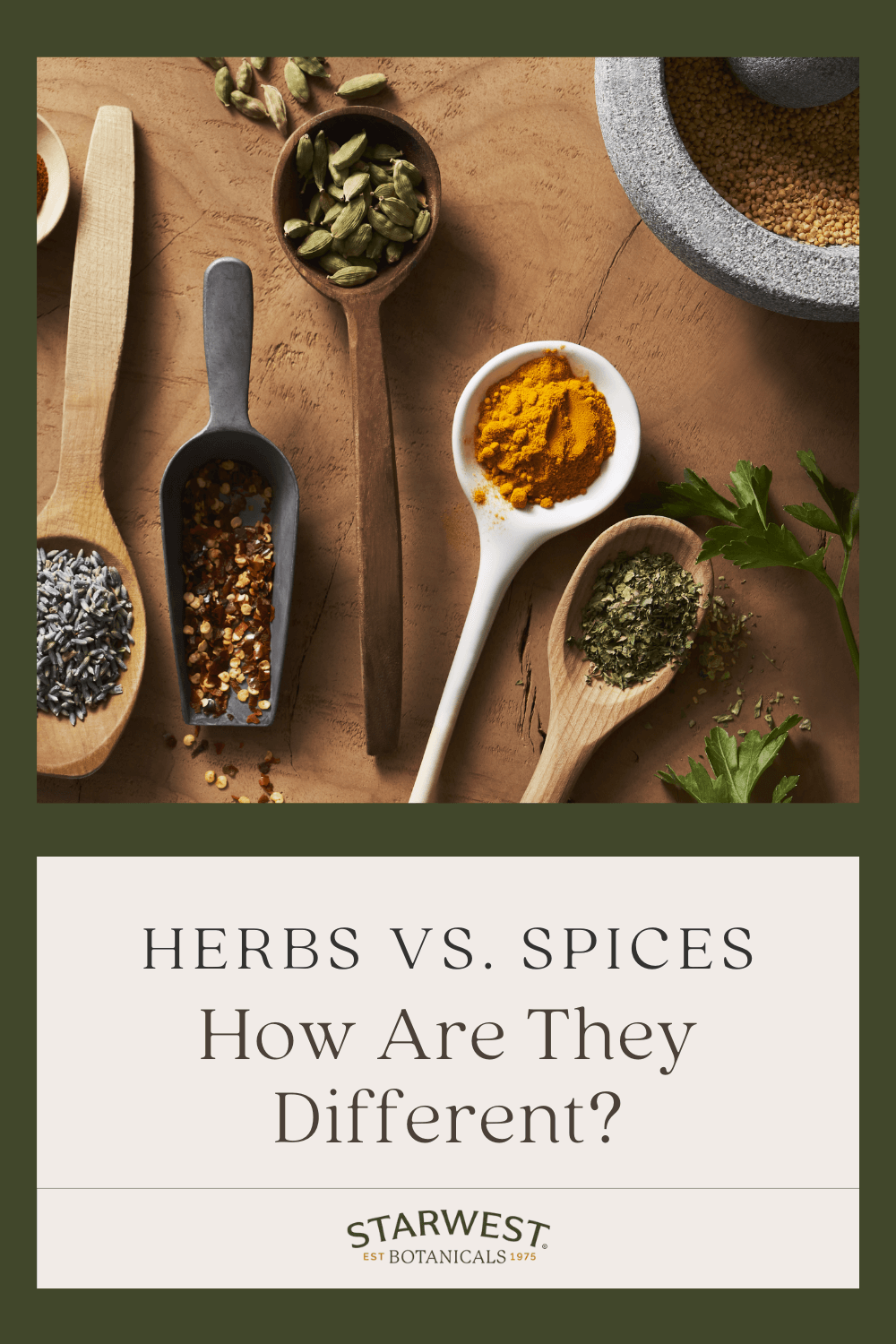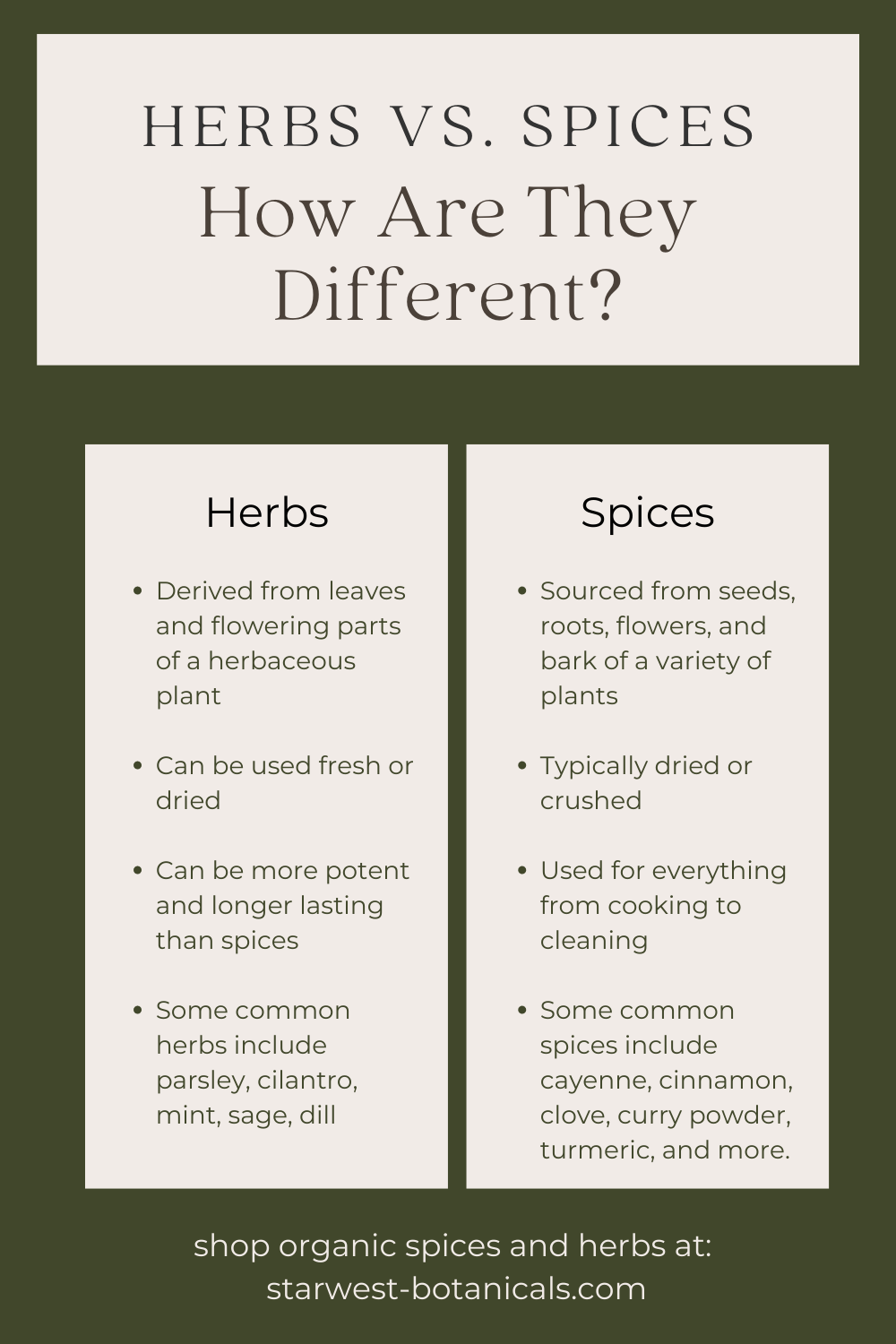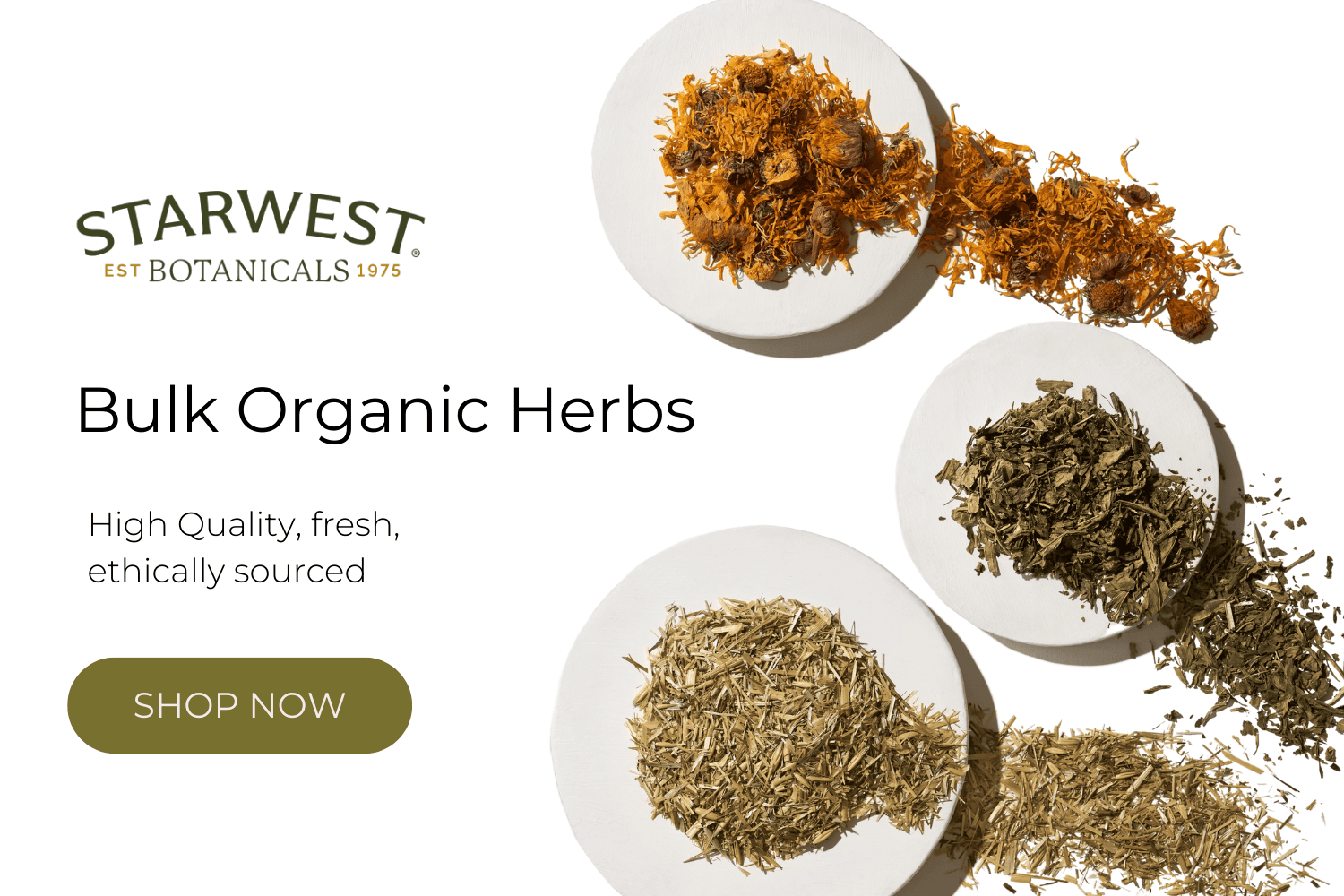Herbs vs Spices: How Are They Different? | Starwest Botanicals
Posted by Starwest Botanicals on 11-14-2022

Herbs vs. Spices: How Are They Different?
Dried herbs and spices have quite a bit in common. They’re both sourced from plants, they were both instrumental in the establishment of global trade, and they both have myriad uses—from flavoring fine cuisine to aromatherapy.
Even if you’ve got years of experience working with fresh herbs and spices, you might not be clear on their exact definitions, or what distinguishes them from one another.
Read on to explore the difference between fresh herbs and spices, and what qualities they share. We’ll cover where they come from, how they’re made, and what they’re best used for.
Let’s dive into the science, the history, and the flavor.
The Differences Between Herbs vs. Spices
The main differences between culinary herbs and spices are rooted in what they’re made of and how they’re processed. While they certainly aren’t polar opposites, there are clearly observable patterns that separate each into two distinct categories:
- Herbs – Culinary Herbs are derived from the leaves and flowering parts of a herbaceous plant. Herbs can be used either fresh or dried, and they can be more potent and longer-lasting than spices. Some common dried herbs include parsley, cilantro, mint, sage, and dill.
- Spices – Unlike herbs, ground spices are sourced from seeds, roots, flowers, and bark of a variety of plants. They are typically dried or crushed and used for everything from cooking to cleaning. Some common ground spices include cayenne, cinnamon, clove, curry powder, fennel seed, turmeric, and more.

Common Uses Throughout History
Herbs and spices have been used for innumerable purposes since the very beginning of recorded history. They’ve both been used:
- As a plant-based remedy to manage wounds.
- As incense in religious ceremonies
- As a natural air freshener for homes and living spaces.
Herbs and spices have been used in cuisine for equally as long, if not longer. People in the ancient world even ascribed meaning to herbs and spices, both as powerful symbols and as literal currency. The pursuit of new flavors, aromas, and effects from herbs and spices motivated much of the global economy for centuries.
3 Modern Uses for Herbs and Spices
Spices and herbs still fulfill many of the same uses they’ve had throughout history—though the science behind them is a bit more exact these days. Thanks to continued research, we discover more ways to utilize them with each passing year.
Here are just a few modern uses for herbs and spices.
#1 In Food and Beverage
Herbs and spices are an indispensable tool in the cooking process. From home cooks to professional chefs, countless food enthusiasts use herbs and spices to prepare their savory dishes.
There are several ways to put them to use in the cooking process:
- In dry seasoning rubs
- As central components in sauces and marinades
- As a garnish
- To add flavor, aroma, complexity and micronutrients to practically any savory dishes
#2 For Wellness
Spices and herbs have long been thought to possess practical health benefits. More and more studies are being done on the exact science behind their benefits, but there are already some observable trends in the medicinal properties of these plants:
- Turmeric – It’s a common supplement for people who are watching their heart health and their sugar intake.
- Ginger – Ginger has been used for millennia as a way to help alleviate gastrointestinal discomfort. It may also help to relieve motion-sickness and pregnancy-related nausea.
#3 In Beauty Applications
The beauty industry has made generous use of both spices and medicinal herbs for quite some time. Modern advances in science and technology have allowed us to identify exactly why certain dry herbs and spices might be useful in cosmetics.
Here are a few possible qualities of dry herbs and spices that are touted by the beauty industry:
- Protection support against free-radicals, common in black and green tea, and grape seed
- Potential hair growth, often linked to grape seed, rosemary, and sage

Starwest Botanicals: Your Source for Herbs and Spices
Understanding the differences and similarities between herbs and spices is key to making the best use of them. It’s also key to sourcing and producing them.
At Starwest Botanicals, we’ve dedicated nearly fifty years to the pursuit of quality herbs and spices—meaning we know our stuff. So, whether you’re looking for flavor-packed dishes, herbal remedies, or plant-based beauty care, we’ve got you covered.
We aim to provide spice and herb enthusiasts with carefully-sourced, trustworthy ingredients. From dried oregano, thyme, bay leaf, pepper, and more, we always provide our customers with a 100% satisfaction guarantee.
Starwest Botanicals is your source for high-quality botanicals, whether you’re looking for medicinal herbs, ground spices, or anything in between.
Sources:
World History Encyclopedia. The Spice Trade & the Age of Exploration. https://www.worldhistory.org/article/1777/the-spice-trade--the-age-of-exploration/
Britannica. What’s the Difference Between an Herb and a Spice. https://www.britannica.com/story/whats-the-difference-between-an-herb-and-a-spice
Britannica. Spice and Herb. https://www.britannica.com/topic/spice-food
Johns Hopkins. 5 Spices With Healthy Benefits. https://www.hopkinsmedicine.org/health/wellness-and-prevention/5-spices-with-healthy-benefits
Research Gate. Plants Used in Cosmetics. https://www.researchgate.net/publication/9027603_Plants_Used_in_Cosmetics


